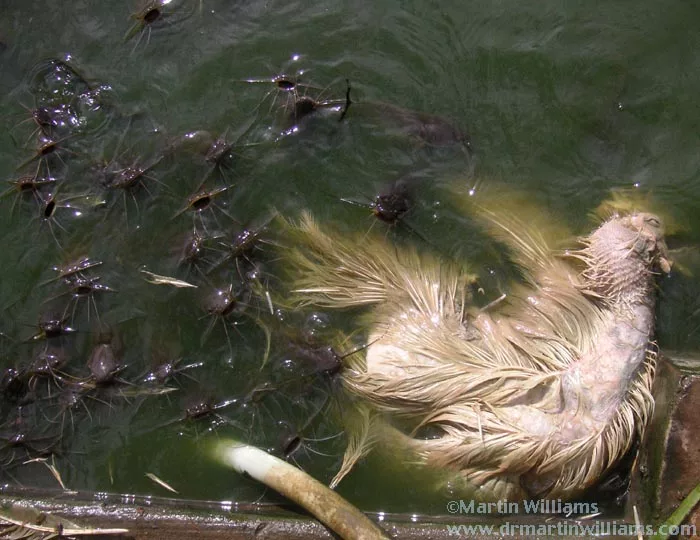In 1953, PhD student Stanley Miller conducted an experiment that seemed so outlandish that he had to persuade his supervisor Harold Urey to let him try it. Working in a laboratory in the University of Chicago, US, he injected steam into a mixture of methane, ammonia and hydrogen — to simulate the early atmosphere on earth. Then, he applied an electric discharge, mimicking lightning, and left the mixture to react for a week.
Analysing the resulting liquid within his flask, Miller found five amino acids — carbon based chemicals that also include elements such as oxygen and nitrogen and are the building blocks of proteins, which in turn are essential to life as we know it.
This landmark experiment fit a notion of Charles Darwin’s, described in a letter to a friend: “But if (and Oh! What a big if!) we could conceive in some warm little pond, with all sorts of ammonia and phosphoric salts, lights, heat, electricity etc., present that a protein compound was chemically formed ready to undergo still more complex changes.”
Yet while there was great appeal in the idea that the warm little pond – often known as “primordial soup” – could support a progression from amino acids to proteins, and eventually to replicating cells containing DNA, there soon came a realization that a huge gulf separated the Miller-Urey experiment from any plausible pathway to even the simplest life forms.
The origin of life remains a mystery. Even so, there have been several announcements of research results providing tantalizing clues as to ways life could have arisen – with indications that some important components may have extraterrestrial origins.
Life began with RNA, on earth
One popular theory for how life emerged from the soup is that it began with RNA – ribonucleic acid, a family of very long molecules with a similar structure to DNA. In 2009, a team at the University of Manchester, UK, announced that they had created one of the building blocks of RNA in an experiment involving simple chemicals and conditions similar to those that may have existed on ancient earth. “What we have ended up with is molecular choreography,” said lead author John Sutherland, quoted in a Nature article.
As seems typical of work on the origins of life, some scientists are critical of the experiment, which echoed the one conducted by Miller but was more complicated, involving steps like heating molecules in water, evaporating the water, and irradiating the molecules with ultraviolet light. Undeterred, Sutherland said, “My ultimate goal is to get a living system (RNA) emerging from a one-pot experiment.”
Adding support to the idea that self-replicating RNA was a precursor to life on earth, in August this year a team of University of Washington scientists reported that they had found ways that primitive cells could have formed. Their experiments involved combining organic chemicals called fatty acids with building blocks of RNA. In some cases, the fatty acids formed tiny soapy bags containing the building blocks. Maybe the chemistry leading to RNA occurred in similar bags.
But scientists have calculated that random evolution of RNA molecules could take an extremely long time to reach their modern sophistication. Last month, Charles Carter of the University of North Carolina, US, published the results of a study suggesting enzymes could have accelerated the process. His experiments are based on recreating something like ancient enzymes, and have shown that these significantly enhance the reactions necessary for translating the genetic code.
Mars may have suited chemistry to kickstart life
Another origins-of-life chemist, Steven Benner of the Westheimer Institute of Science and Technology, US, has suggested that assembling RNA would have been very difficult on the ancient earth. Speaking at a conference in August, he presented results indicating that boron and molybdenum minerals can significantly help the process. But three billion years ago, the Earth was too wet and the atmosphere had too little oxygen for these minerals to have been sufficiently common and in the right forms.
Instead, Benner suggested that Mars had the right chemistry, and life may have come to earth on a Martian meteorite. “The evidence seems to be building that we are actually all Martians; that life started on Mars and came to Earth on a rock,” he remarked.
Within days of Benner’s presentation, a paper was published that had reached similar conclusions regarding the “phosphate problem” – concerning the phosphorus compounds crucial for RNA, DNA, and proteins. There would have been few such compounds in the water on early Earth, but Martian phosphates were both more soluble and plentiful, making the Red Planet appear a better nursery for life.
Just possibly, fossil microbes have been found in meteorites from Mars. The most famous of these meteorites made world news in 1996, when NASA scientist David McKay argued that tiny structures were fossils of lifeforms smaller than any known cellular life. Three years ago, a team including McKay reported that abundant fossil-like structures had been discovered in other Martian meteorites. However, scepticism remained widespread.
Meteorites from asteroids are another otherworldly source of ingredients for life. They can be rich in organic material such as amino acids, which may form as comets crash into moons or planets. After a meteor fell to earth over California in April last year, researchers at the University of Arizona gathered fragments for study. At first, they were disappointed to find few organic molecules. Then, they took insoluble material and baked it for six days in conditions akin to those around hydrothermal vents.
“And lo and behold, this meteorite left behind something we have never seen,” team leader Sandra Pizzarello told New Scientist. There were long molecular chains that can form scaffold-like structures. Rather than soapy bags, it might have been this scaffolding that trapped organic molecules which led to life.
Speculation about the origins of life look set to continue. But there is agreement that the earliest known life dates from around 3.7 billion years ago. And last month, British graduate student Andrew Rushby announced that as the sun ages, Earth will become too hot and dry to support life within 1.75 billion to 3.25 billion years. So while there’s no need to panic just yet, if any earthlings are to survive, they will have to find a way to colonise other parts of the universe.
Early warnings of climate change
While climate change resulting from human activities might seem a new-fangled concept, there have been on-point predictions dating back many years.…
Ignoring Science Makes Global Climate Disaster as Inevitable as Titanic Submarine Implosion
Climate change has been prominent in worldwide news this summer (2023), notably as we have just lived through the hottest week…
Have you been bullied into health? Fear, quackery and Covid
So here we are with our modern-day wonder, the internet – where even with a smartphone, you can search for and…
Never mind the antimask-o-sphere. Science shows face masks help reduce Covid spread
Just had one of those silly Twitter “conversations” with someone who had position so fixed, impossible to change with facts. Yeah,…
A Covid scrapbook: snapshots from the crazy pandemic
I’ve read accounts of the Spanish Flu, which was the last major pandemic, mainly in 1918 [so over and done with…
Highly pathogenic bird flu variants mostly evolve in intensive poultry farming
Highly pathogenic bird flu variants evolve from regular, low pathogenic, bird flus, within intensive poultry farming.
Keep Your Underpants Duck Taped and Air Clean as Covid Wild Ride Continues
We’ve learned a lot about Covid, even developing vaccines. Yet Covid remains an issue, no matter how much we might wish…
Covid is airborne so ventilation and air filtration are important
Since early in the pandemic, I’ve been seeing scientists arguing Covid is airborne, even with hashtag #covidisairborne – including to counter…
Long Covid – info and links indicating major impact
Evidence is snowballing that Long Covid is also a serious issue, even affecting people in whom the disease initially appeared mild.
Perhaps Covid arose through lab leak of tweaked bat Coronavirus
Maybe humans tweaked bat coronaviruses in gain of function experiments, inadvertently creating Covid thro lab leak.
The Covid Conundrum: Endless Lockdowns, Let It Rip … or What?
Covid is airborne, which means that much as unprotected sex is a risk for HIV, unprotected breathing might result in Covid.
Science shows Covid including Omicron is Really Not the Flu
Some of the science showing Covid including Omicron is a huge issue; and one that looks set to be with us…
“Alarmist” Covid predictions outperform Covid deniers’ soothsaying
The disinfo downplaying Covid is often from rightwing, mainly money-minded folks who perhaps don’t care too much about actual people.
Covid virulence, vaccines and variants
Science can provide some insights into what may happen with Covid, along with ways to limit its impacts.
We’re in the Covid Era for the Long Haul
We’re in this for the long haul, with the virus like a relentless, invisible foe, ready to exploit errors, slip through…
My Strange n Surprising Summer Staycation with Cellulitis
rom quick pricking by unseen marine creature, to intense fever, and hospital stay for an infection deep within the skin.
Covid virulence, vaccines and variants
[Written for South China Morning Post on 6 January 2021] In January last year, as reports were emerging of the new…
The Viral Time Bomb – Pandemic of Our Time
Guan Yi, director of the State Key Laboratory of Emerging Infectious Diseases at Hong Kong University, has extensive experience of viruses;…
From China With Fear: the Wuhan Coronavirus Won’t Kill Us All
As news of Wuhan coronavirus emerges, evolutionary biology suggests potential for a pandemic, not killing high percentage of people.
Fightback Needed as Science and Life Support System Under Attack
Environmentalism is under assault; yet this planet is the only home we have; providing our food, air, water… It’s our life…
Secret World of Hong Kong Water Supply
Hong Kong’s water supply system has been vital to its development as a “world city”.
Hong Kong Belching Buffaloes n Bubbling Paddies and the Mystery Methane Rise
Prof Euan Nisbet leads a science team to Hong Kong in quest to help find why levels of potent greenhouse gas…




















